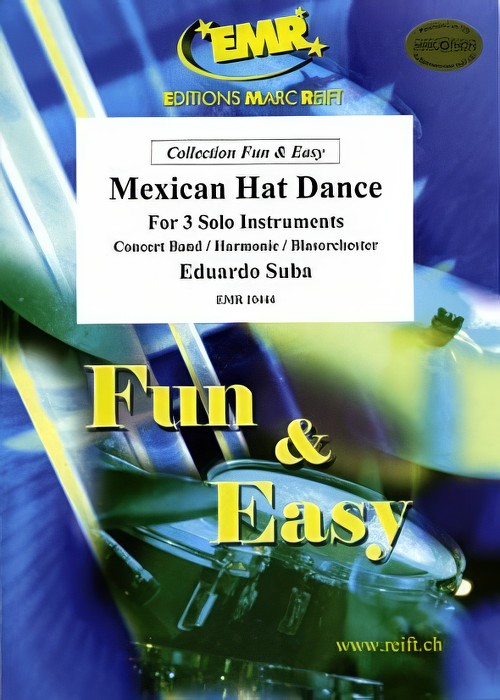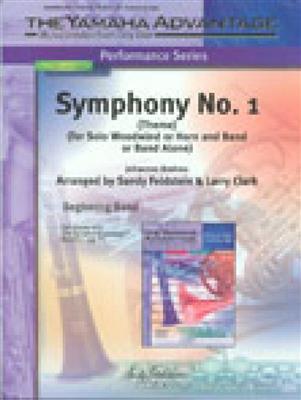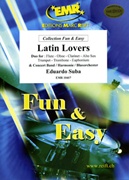Results
-
 £96.40
£96.40The Elephant and the Fly - Henri Kling
This newly revised edition of perennial favorite "The Elephant and the Fly" is based on the original parts published in 1918. This updated version includes a full score, in addition to a few adaptations/transpositions to accommodate modern band instruments. Lastly, each of the solo parts is transposed into a variety of keys, such that a variety of soloist combinations are now possible. Instrumentation: Solo Piccolo (or Flute/Clarinet/Trumpet), Solo Trombone (or Bassoon/Bass Clarinet/Tuba), Flute 1, Flute 2, Oboe 1/2, E-Flat Clarinet, Clarinet 1, Clarinet 2/3, Bass Clarinet, Soprano Saxophone (or alternate Alto Saxophone), Alto Saxophone, Tenor Saxophone, BaritoneSaxophone, Bassoon, Horn 1/3, Horn 2/4, Solo Cornet, Cornet 1, Cornet 2/3, Trombone 1/2, Bass Trombone, Euphonium, Tuba, Percussion
Estimated dispatch 7-14 working days
-
 £104.99
£104.99Divertimento - Roger Boutry
Divertimento is an outstanding composition by Roger Boutry for Alto Saxophone and Wind Orchestra. This great work is really nice to play and will enlighten the audience. The Orchestracomposition required is: 2 Flutes, 2 Oboes, 2 Bassoons, 2 small Clarinets, Clarinet I, Clarinet II, 1 Bass Clarinet, 2 Alto Saxophones, 2 Tenor Saxophones, 1 Baritone Saxophone, 4 Horns, 4 Bb or C Trumpets, 4 Trombone or 3Trombone and an Euphonium, 1 Bb or C Bass, 1 Double Bass, 1 Harp, Timpani, Drum and a Celesta. It is divided into three parts: I. "Allegro ma non troppo", is strongly rhythmic and syncopated.Itincludes a Cadenza by the Solo Saxophone and is written as a tribute to Jazz music. II. "Andante", also includes a Cadenza by the Solo Saxophone but at the end of the section. It is reminiscent of slowerblues ballads. III. This part features few sections by the Solo Saxophone but is specially highlighted its ending, in a bright and fast finale. This volume features the score and parts for all theinstruments. Born in France in 1932, Roger Boutry received numerous prizes, including those for Piano, Composition and Conducting. He received the Grand Prix de Rome in 1954. His career was quite successful,alternating between Harmony professor, composer and conductor. He also received numerous prizes for his incredible compositions.
Estimated dispatch 7-14 working days
-
 £125.00
£125.00Mexican Hat Dance (Flexible Trio with Concert Band - Score and Parts) - Suba, Eduardo
1st Solo part available for: Flute, Clarinet, Alto Sax, Trumpet2nd Solo part available for: Flute, Clarinet, Alto Sax, Trumpet3rd Solo part available for: Flute, Clarinet, Alto Sax, Tenor Sax, TrumpetDuration: 2:00
Estimated dispatch 7-14 working days
-
 £78.99
£78.99The Old Grumbly Bear
For solo bassoon, bass clarinet, baritone saxophone, euphonium, or tuba with band accompaniment.From the Barnhouse "Spotlight" series. This delightful novelty solo includes parts for solo bassoon, bass clarinet, baritone saxophone, euphonium BC and TC, and Tuba. An ideal solo to showcase your star performer's musical abilities in a humorous and fun way. The accompaniment is not difficult, and requires a minimum of rehearsal. An excellent choice for adding variety to your concert in featuring a soloist on a non-typical solo instrument. Great fun!!
Estimated dispatch 7-14 working days
-
 £64.35
£64.35The Old Grumbly Bear - Fucik, Julius
For solo bassoon, bass clarinet, baritone saxophone, euphonium, or tuba with band accompaniment.From the Barnhouse "Spotlight" series. This delightful novelty solo includes parts for solo bassoon, bass clarinet, baritone saxophone, euphonium BC and TC, and Tuba. An ideal solo to showcase your star performer's musical abilities in a humorous and fun way. The accompaniment is not difficult, and requires a minimum of rehearsal. An excellent choice for adding variety to your concert in featuring a soloist on a non-typical solo instrument. Great fun!!
Estimated dispatch 7-14 working days
-
 £87.70
£87.70Introduction and Rondo Capriccioso - Camille Saint-Saëns
A brilliant transcription of this very famous violin solo, utilizing a more chamber-like wind ensemble scoring in order to maintain the delicate balance between the soloist and ensemble. Instrumentation: Solo Flute, C Flute 1, C Flute 2, Oboe 1, Oboe 2, Clarinet 1, Clarinet 2, Bass Clarinet, Bassoon, Horn 1, Horn 2, Trumpet 1, Trumpet 2, Euphonium (T.C. and B.C.), Tuba, Timpani
Estimated dispatch 7-14 working days
-
 £66.00
£66.00La Tourterelle - Eugène Damare
A delightful polka from the "Golden Age" era which features the piccolo in all its glory. This arrangement by Louis W. Lewis will delight any audience and is a great way to introduce the smallest member of the flute family to the audience. Instrumentation: Solo D-flat (or C) Piccolo or Solo Cornet (Baritone), C Flute 1/2, Oboe 1/2, Bassoon, E-Flat Clarinet, Clarinet 1, Clarinet 2/3, Alto Saxophone 1/2, Tenor Saxophone, Baritone Saxophone, Cornet 1, Cornet 2, Cornet 3/4, Horns 1/2, Horns 3/4, Trombone 1/2, Trombone 3/Bass Trombone, Baritone (T.C. and B.C.), Basses (Tuba), Percussion (Snare Drum, Bass Drum, Triangle)
Estimated dispatch 7-14 working days
-
 £43.99
£43.99Symphony No. 1 Theme - Sandy Feldstein
The Johannes Brahms Symphony No. 1 Theme is designed to give your best players an opportunity to play a solo with band accompaniment. This solo is the same one that appears on page 36, book 1 of The Yamaha Advantage for oboe, bassoon, alto clarinet, tenor saxophone and horn. This arrangement also includes solo parts for Flute, Clarinet and Alto Saxophone. This piece can also be performed by band alone.
Estimated dispatch 7-14 working days
-
 £57.95
£57.95LATIN LOVERS (Flexible Duet/Easy Concert Band) - Suba, Eduardo
Duo for 2 Solo Instruments. Solo I: Flute - Clarinet - Alto Sax - Trumpet - Trombone - Euphonium. Solo II - Flute - Oboe - Clarinet - Alto Sax - Trumpet - Trombone - Euphonium. American Grade 2+. Duration: 4:12
Estimated dispatch 7-14 working days
-
 £39.60
£39.60Symphony No.1 Theme (Concert Band - Score and Parts)
The Johannes Brahms Symphony No. 1 Theme is designed to give your best players an opportunity to play a solo with band accompaniment. This solo is the same one that appears on page 36, book 1 of The Yamaha Advantage for oboe, bassoon, alto clarinet, tenor saxophone and horn. This arrangement also includes solo parts for Flute, Clarinet and Alto Saxophone. This piece can also be performed by band alone.
Estimated dispatch 7-14 working days
